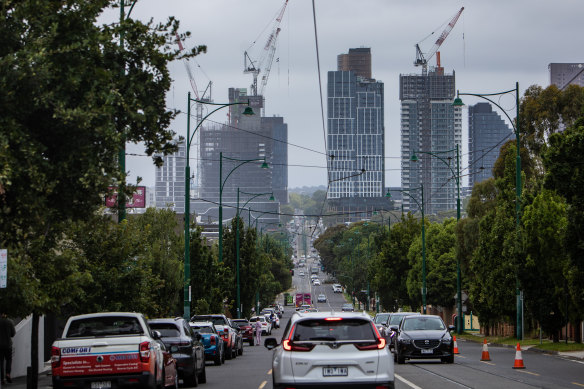The Suburban Rail Loop is a transport project like no other in Victoria’s history. And it’s not just its enormous cost – the bill for the first stage could reach $34.5 billion – that is unprecedented. The project is also triggering a development boom.
The state Labor government hopes to by 2056 cram twice as many residents as there are now and jobs into a 1.6-kilometre radius around each of the six new stations earmarked for the first stage: Cheltenham, Clayton, Monash, Glen Waverley, Burwood and Box Hill.

To reach that target, residential towers of up to 25 storeys will be allowed above most stations, while in Box Hill, a 50-storey tower has already been given the green light. The building spree is being expedited by the government’s Development Facilitation Program, which fast-tracks projects by bypassing the usual council planning hurdles.
All up, the new high-rise towers are expected to deliver more than 70,000 homes to cater for Melbourne’s booming population, which is expected to hit 6.45 million by 2034 – an increase of more than 1 million on today’s population. That’s a lot of people to manage in a city where much of the health, education and transport infrastructure is already under pressure.
For decades, Melbourne has spread outwards, first along the veins of its rail lines, then filling the car-dependent spaces in between. That has been the simplest and most popular way to provide the affordable housing that has underpinned the city’s expansion. The Achilles heel of this approach is, so often, the much promised but rarely delivered infrastructure and services that are taken as a given in Melbourne’s inner and middle suburbs.
As a result, The Age broadly agrees with the principle that the bulk of extra housing needed for the city’s expanding population should be absorbed into Melbourne’s current boundaries. But that principle comes with caveats.
The Age

I like this report/editorial from the Age Newspaper thanks for sharing on this platform. To me the biggest issue facing the project is not the cost as this can be recovered in the way we are now seeing with development along the route something that has not really occurred enough over the decades. We don’t see a lot of high density housing being developed over the lines or around hubs as yet adding to that industry hubs have also not been developed around heavy rail corridors adding to the issues with car dependency in Melbourne.
The issue I see is the time it will take to deploy this project 2055 is a long way away and the city needs this access now not on 31 years time if this date is accurate.